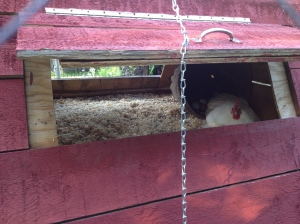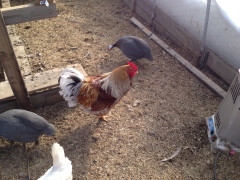Welcome to Chicks 101!
So, you’ve made an impulse purchase of some cutey-patootie chicks or, you’re planning on buying some cutey-patootie chicks and you don’t know what to do. You’re not alone – that’s how most of us got started with our backyard chickens. Hopefully this overview will help you figure out that chicks are easy, mistakes will happen, but in the end you’ll have some lovely, friendly, and egg-producing chickens in your backyard.
You bought chicks! Now what do you do?
Relax! Their needs are simple: Home, Heat, Food, Water. First, their home.
It can be almost anything… a plastic or metal tub, an old aquarium, basically anything that encloses them, contains their food, water, bedding, and can handle a heat lamp. Keep in mind, you’ll want some kind of breathable cover sooner rather than later. As they begin jumping around, exercising their little legs and wings, they can jump out and you don’t want that. For me, the best bedding is flat newspaper when they are really little, graduating to wood shavings at around 2 to 3 weeks. The number of chicks and size of their home will determine the frequency of cleaning but no less than once a week.
And don’t forget they need room to grow. Generally you’ll graduate to a bigger home at least once, maybe more. Again, it’s dependent on the number of chicks. But they need room to move and to be able to sleep apart from the others, if the chick prefers. Crowded chicks can pick up bad pecking habits.
Food & Water: If you don’t have a regular chick feeder or waterer, you can use shallow bowls until you get those items. Keep the water low, and refill frequently. It gets dirty very quickly and the chicks can drown if it is too deep. When you do get a waterer, you might want to put some rocks in it to keep the chicks from falling in. Of course, it’s all dependent on the size of the waterer and the size of the chicks. Use your best judgement and when in doubt, err on the side of caution. And yes, the waterer will need to be cleaned frequently, although generally not as often as a shallow bowl or dish.
Start the chicks off on mash (available at a feed store or Blue Seal or Agway). I tend to use medicated, but only if the chicks I’ve purchased have not been vaccinated. Since you generally have to request it, you’ll know if they are or not, plus the information is sent with the chicks. If you purchase them from an auction, feed store, etc., you don’t know if they’ve been vaccinated. Don’t take someone’s word for it – you need a copy of the certificate. If you don’t know, get the medicated mash. Again, err on the side of caution.
I generally graduate the chicks from crumbles to granules around 5 weeks and to big girl food (pellets) around 10 weeks. It’s a judgement call for me and depends on where I’m at with their feed. Since I generally have enough chicks to buy a 50 lb bag of food, if I’m worried a bag will go to waste, I’ll buy the next step up and phase it in so they get used to the new texture and food type.
ALWAYS keep them watered and fed. Keep the water as clean as you can.
Heat: This is a little more tricky. You truly need a heat lamp the first few weeks, regardless of where they are housed or what the weather is. It needs to be a few inches above their heads. Watch their body language. If they are crowding under the lamp or running around looking confused, it’s too far up. If they are scattering to the far reaches of their home, it’s too close. The general rule of thumb as they age is to move it up about an inch a week until they are fully feathered. Again, watch the body language. They may need the lamp longer if the weather is exceptionally cold. They may need it removed sooner if the weather is extremely hot.
Let me give you two examples:
- I removed the lamp from this year’s chicks after four to five weeks because the weather was exceptionally hot and their cage, housed in the addition we’re building, was not drafty. I watched them closely and they were fine. No loss of life and no crawling on each other to keep warm.

- When we purchased the guinea keets last year, it was so incredibly hot and there were no drafts (they were housed inside), we used a low-heat lamp initially and two of the keets died. When I saw a third one exhibiting the symptoms of the two who had died, I immediately put on a hotter lamp as it was the only thing I could think of. Fortunately, it worked. They fell asleep almost immediately and behaved more normally after that. Good thing to keep in mind: If your keets are running around 24-7 and sleeping for 30 seconds at a pop, chances are they are cold. Get those little babies warm!
It’s been 10 weeks and they have feathers and are too big for their home! What now?
Start getting them used to the big outdoors. I bring them out during the day (penned and in the shade of course!) and put them back in their crate/box at night for about a week. They generally like sleeping close together so I don’t worry about the crowding at night. The outdoors is scary for a creature who’s never really seen it and I like to reduce the trauma. After the first week, they move outside. The first night, I usually lock them into their coop so they know what it is and that’s where to go at night. After the first evening, you should be okay – they’ll go in on their own. Now, if the flock is free-range (and my was for a while), I keep them penned during their adjustment period. Usually another week. Now my flocked is penned, but cage free. Keeps the garden safe.
As with everything else, use your judgement and watch their behavior. When they start going outdoors, it can be weather dependent, especially if their area is not weather proof. You don’t want them getting sick or dying from exposure. As always, ensure they have plenty of food and water, shade, and room to roam.
I have a flock already and need to integrate the new birds.
That’s always an interesting challenge. I’ve had the most success letting the birds get to know each other in separate cages for as long a period as possible. The current set of chicks (well, now true pullets) will be slowly integrated at about 16 weeks. By this time, I’ve culled the ones that are going in the freezer or are being sold. The chicks have been penned, either daytime only or fully for about 10 weeks. The hot weather of the summer really helped as I didn’t have to worry about their getting too cold as they adjusted to the outside. Since their current area is penned off the original flock’s pen, I’m going to peel back the separating fence a bit and let the flocks interact for about a week. As long as there are no major issues, I’ll keep it open and then remove the separating fence, pullet crate, food, and water. Then, if they’re not using the main flock’s feeder and water, they will be forced to. If they don’t go into the coop on their own after they lose their place, I’ll put them in manually and lock it up for the night. I’ll update this post after the integration so you’ll know if my plan worked or not.
At the end of the day, sometimes things will happen. Chicks may die and you just don’t know why. An attrition rate of roughly 20% is supposed to be normal, although I’ve never been fond of it. I will say this batch of chicks from McMurray all lived, as did the smaller batch my husband bought from Tractor Supply last year. And I had a keet slip through the fence when I was getting them used to the big outdoors last year in addition to the two who died before I put them under the hot lamp. I never could catch that little sucker and he/she ended up contributing to the great circle of life. Sometimes the best laid plans fail and sometimes they just take a long time to implement. But don’t give up! The chickens are great for their eggs and soothing clucks. So take a deep breath and relax. It will work out.
I’ll update Chicks 101 from time to time — and it will have it’s own page for quick reference. My goal is for you to learn from my mistakes and make your backyard chicken experience more enjoyable and less stressful. Feel free to ask questions and I’ll answer to the best of my knowledge.
UPDATE:
Well, I did a forced integration a couple of weeks sooner than anticipated. I went out a couple of nights ago to put Guapo away and turn on the lights and radio (for security). First, I surprised the guineas off the porch. Odd, as they have not wanted to roost on the porch for almost a year. They went into the pen fine, when I opened it up to get Guapo. After I put him into his evening quarters, I saw the guineas were on top of the fence. Okay. Weird, but not unusual weird. When I turned on my little security measures, I saw the younglings were freaking out. They would not go into their box and were trying to get into the “big girl” pen. So, I let them. Of course, now they were totally discombobulated and tried perching for the night. It was going to be cold and I did not feel comfortable leaving them there and physically moved them into the top of the coop.
I did that for two nights.
Tonight they decided to sleep in their pen. I’ll let them, but as it gets colder, I’ll have to get them fixated on the coop. Challenges challenges!
They’re getting along with the big girls for the most part. However, the Reds and Dirty Girl like to be bossy and terrorize them a bit. Not attacking, at least not what I’ve seen, but just walk around and look at them. Chicken culture. Interesting.
And the Disclaimer: I don’t claim to be an expert. I’m relating my experiences and what worked/didn’t work for me. While I would love to make you a guarantee, I simply can’t. Live is too full of variables and uniqueness. It’s what makes life fun. So keep at it, treat your birds well, and enjoy!














